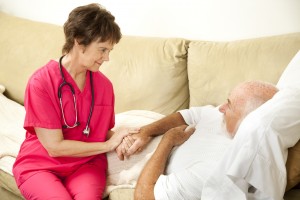A health care professional may have the best possible technical skills, and encyclopedic knowledge, but one more element is needed to be truly effective: empathy.
Studies have shown that this important attribute has been declining amongst nursing and medical students. The benefits of empathy go far beyond the exam room. Greater empathy levels is associated with fewer medical errors, better patient outcomes, more satisfied patients, and fewer malpractice claims.
Traditionally, empathy has been thought to be inherent — you have it, or you don’t. This article in the New York Times looks at some of the new research that indicates that it can be taught.
Building on research over the last decade that has shown that empathetic observers have brain activity, heart rate and skin electrical conductance that mirror those of the person undergoing the emotional experience — observing a friend’s hand getting slammed in a car door, for example, causes us to flinch because an image of the accident gets mapped onto the pain and threat sensors in our own brain — Dr. Helen Riess, director of the Empathy and Relational Science Program in the department of psychiatry at the Massachusetts General Hospital in Boston, created a series of empathy “training modules” for doctors. The tools are designed to teach methods for recognizing key nonverbal cues and facial expressions in patients as well as strategies for dealing with one’s own physiologic responses to highly emotional encounters.
In one lesson, for example, doctors watch a video of a tense exam room interaction while a striking graphic sidebar records the electrical skin conductance of both patient and doctor, the mismatched spikes peaking as each person’s frustration with the other escalates. Another lesson walks doctors through a series of pictures of a patient whose face expresses anger, contempt, happiness, fear, surprise, disgust or sadness.
To test the effectiveness of the lessons, Dr. Riess and several of her colleagues enrolled about 100 doctors-in-training and asked their patients to evaluate their empathy, based on the doctor’s ability to make them feel at ease, show care and compassion and fully understand patient concerns. Half of the doctors then took part in three one-hour empathy training sessions.
Two months later, the researchers asked a second group of patients to evaluate all the doctors again. They found that the doctors who had taken the empathy classes showed significant improvements in their empathetic behavior, while those who had not actually got worse at empathizing with patients.
“People tend to believe that you are either born with empathy or not,” said Dr. Helen Riess, lead author of the study. “But empathy can be taught, and you can improve.”
Compared with their peers, doctors who went through the empathy course interrupted their patients less, maintained better eye contact and were better able to maintain their equanimity if patients became angry, frustrated or upset. They also appeared to develop resistance to the notorious “dehumanizing effects” of medical training. After the empathy classes, one physician who had complained about being burned out said, “I feel as though like I like my job again.”
Responses to this study have so far been enthusiastic, in part because it is one of the first to rely on patient evaluations of empathy rather than physician self-assessment. “The holy grail of this kind of research is whether patients think doctors are empathic, not whether the doctors think they are,” Dr. Riess said. She and her colleagues plan to expand their research and offer the training to more doctors, as well as to nurses, physician assistants and others.
“We are in a special place in the history of medicine,” she said. “We have the neurophysiology data that validates and helps move medicine back to a real balance between the science and the art.”
Curious to know whether the empathy course worked, I decided to try out what I had learned in researching this column. The next day at the hospital, I took extra care to sit down facing my patients and not a computer screen, to observe the changing expressions on their faces and to take note of the subtle gestures and voice modulations covered in the course. While I found it challenging at first to incorporate the additional information when my mind was already juggling possible diagnoses and treatment plans, eventually it became fun, a return to the kind of focused one-on-one interaction that drew me to medicine in the first place.
Just before leaving, one of the patients pulled me aside. “Thanks, Doc,” he said. “I have never felt so listened to before.”

